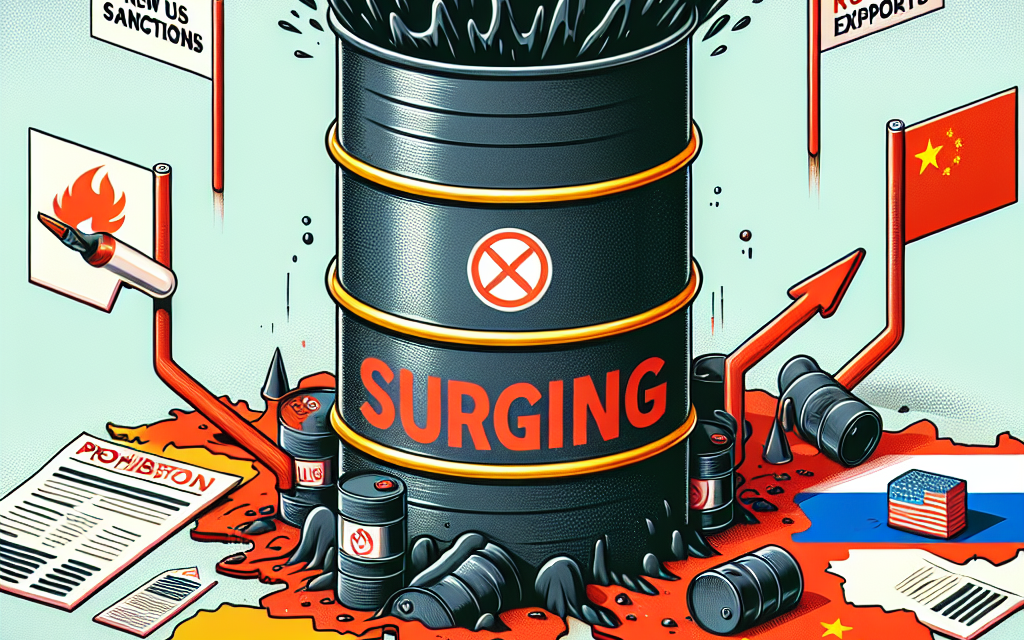“Oil Prices Soar as New US Sanctions Hit Russian Exports to China and India.”
Introduction
Oil prices have surged in response to the latest round of U.S. sanctions aimed at curbing Russian energy exports to key markets in China and India. These sanctions, designed to further isolate Russia economically following its actions in Ukraine, have created significant uncertainty in global oil supply chains. As major consumers like China and India grapple with the implications of these restrictions, the market is reacting to potential disruptions in oil availability, leading to increased prices. This development underscores the intricate interplay between geopolitical tensions and energy markets, highlighting the vulnerabilities of global oil supply amid shifting alliances and economic pressures.
Impact of US Sanctions on Global Oil Prices
The recent imposition of new U.S. sanctions targeting Russian oil exports to China and India has sent shockwaves through the global oil market, leading to a significant surge in oil prices. As the world’s major economies grapple with the implications of these sanctions, the interconnectedness of global energy markets becomes increasingly evident. The sanctions, aimed at curbing Russia’s revenue from oil sales amid ongoing geopolitical tensions, have created a ripple effect that is influencing supply and demand dynamics across the globe.
Initially, the sanctions have led to a tightening of the oil supply, particularly as Russia has historically been one of the largest exporters of crude oil. With the U.S. targeting key markets such as China and India, which have been significant importers of Russian oil, the immediate consequence is a reduction in the availability of Russian crude on the international market. This reduction in supply, coupled with the ongoing recovery of global demand as economies emerge from the pandemic, has resulted in upward pressure on oil prices. As buyers scramble to secure alternative sources of crude, the competition for available oil has intensified, further exacerbating price increases.
Moreover, the sanctions have prompted a reevaluation of trading relationships and supply chains. Countries that previously relied heavily on Russian oil are now seeking to diversify their energy sources, which has led to increased demand for oil from other producers. This shift in demand dynamics has not only affected prices but has also created opportunities for other oil-exporting nations to fill the void left by Russian exports. For instance, countries in the Middle East and North America are likely to benefit from this situation, as they can ramp up production to meet the needs of countries looking to replace Russian oil.
In addition to the immediate supply concerns, the sanctions have also introduced a layer of uncertainty into the market. Traders and investors are now faced with the challenge of navigating a landscape marked by geopolitical risks and fluctuating supply chains. This uncertainty often leads to increased volatility in oil prices, as market participants react to news and developments related to the sanctions and their broader implications. Consequently, oil prices may experience sharp fluctuations as the market adjusts to the evolving situation.
Furthermore, the impact of these sanctions extends beyond the immediate oil market. Higher oil prices can have a cascading effect on global inflation, as energy costs are a significant component of overall consumer prices. As oil becomes more expensive, transportation and production costs rise, which can lead to increased prices for goods and services. This inflationary pressure can create challenges for central banks, which may need to adjust monetary policy in response to rising prices, potentially slowing economic growth.
In conclusion, the new U.S. sanctions targeting Russian oil exports to China and India have had a profound impact on global oil prices, leading to a surge that reflects the complexities of the current geopolitical landscape. As supply chains are disrupted and countries seek alternative sources of energy, the market is likely to remain volatile. The broader implications of these sanctions, including potential inflationary pressures, underscore the interconnected nature of global economies and the critical role that energy markets play in shaping economic outcomes. As the situation continues to evolve, stakeholders across the globe will need to remain vigilant and adaptable in response to the changing dynamics of the oil market.
Russia’s Response to Sanctions: Strategies and Consequences
In response to the recent sanctions imposed by the United States targeting Russian oil exports to key markets such as China and India, Russia has been compelled to adopt a series of strategic measures aimed at mitigating the impact of these economic restrictions. The sanctions, which are designed to curtail Russia’s revenue from oil sales, have prompted the Kremlin to reassess its export strategies and seek alternative avenues for maintaining its economic stability. As the global oil market reacts to these developments, it is essential to understand the multifaceted responses from Russia and the potential consequences of these actions.
One of the primary strategies employed by Russia involves diversifying its export markets. Historically reliant on Europe for a significant portion of its oil sales, Russia is now intensifying efforts to strengthen its ties with Asian countries, particularly China and India. By enhancing bilateral trade agreements and offering competitive pricing, Russia aims to secure its position as a key energy supplier in these rapidly growing economies. This pivot towards Asia not only helps Russia to offset the loss of European markets but also fosters deeper geopolitical ties with nations that are increasingly asserting their influence on the global stage.
Moreover, Russia is exploring alternative payment mechanisms to circumvent the financial restrictions imposed by the sanctions. The Kremlin has been advocating for the use of national currencies in trade transactions, thereby reducing reliance on the US dollar. This shift not only aims to protect Russia’s economic interests but also aligns with a broader trend among several countries seeking to diminish the dominance of the dollar in international trade. By promoting the use of the ruble and other currencies, Russia hopes to create a more resilient economic framework that can withstand external pressures.
In addition to diversifying markets and payment methods, Russia is also investing in its domestic oil production capabilities. The government has announced plans to enhance infrastructure and technology in order to boost output and reduce production costs. This focus on self-sufficiency is critical, as it allows Russia to maintain its status as a leading oil producer while navigating the challenges posed by sanctions. Furthermore, by investing in advanced extraction techniques, Russia aims to tap into previously inaccessible reserves, thereby ensuring a steady supply of oil to its new and existing markets.
However, these strategies are not without their consequences. The shift towards Asian markets may lead to increased competition among oil suppliers, potentially driving down prices in the long term. Additionally, while Russia may find temporary relief in diversifying its markets, the long-term sustainability of this approach remains uncertain. The geopolitical landscape is continually evolving, and reliance on a limited number of markets could expose Russia to new vulnerabilities.
Furthermore, the sanctions have prompted a reevaluation of Russia’s energy policies, leading to a potential increase in domestic consumption of oil and gas. As the government seeks to bolster its economy in the face of external pressures, there may be a shift in focus towards meeting domestic energy needs, which could impact export levels in the future. This internal demand could create a complex balancing act for Russia, as it navigates the dual objectives of sustaining its economy while maintaining its role as a global energy supplier.
In conclusion, Russia’s response to the US sanctions targeting its oil exports is characterized by a multifaceted approach that includes market diversification, alternative payment mechanisms, and increased domestic production. While these strategies may provide short-term relief, the long-term consequences remain uncertain, as Russia grapples with the challenges posed by a rapidly changing global energy landscape. The interplay between these factors will undoubtedly shape the future of Russia’s oil industry and its position in the global market.
The Role of China and India in the Global Oil Market
The global oil market is intricately linked to the economic dynamics of major players, particularly China and India, which have emerged as pivotal consumers in recent years. As the world’s two most populous nations, their energy demands are substantial and continue to grow, significantly influencing global oil prices and trade patterns. The recent surge in oil prices, driven by new U.S. sanctions targeting Russian exports to these countries, underscores the critical role that China and India play in shaping the energy landscape.
China, as the largest importer of crude oil, has established itself as a dominant force in the global oil market. Its rapid industrialization and urbanization have led to an insatiable appetite for energy, making it a key player in determining oil demand. The country’s strategic initiatives, such as the Belt and Road Initiative, further enhance its energy security by diversifying its sources of oil imports. Consequently, any shifts in China’s purchasing behavior can have immediate repercussions on global oil prices. The recent sanctions aimed at curtailing Russian oil exports to China may lead to a recalibration of supply chains, prompting China to seek alternative sources or negotiate more favorable terms with other oil-producing nations.
Similarly, India has emerged as a significant player in the global oil market, with its energy consumption steadily increasing due to economic growth and rising living standards. As the third-largest oil importer, India’s demand for crude oil is expected to rise, driven by its expanding transportation sector and industrial activities. The recent U.S. sanctions on Russian oil exports could compel India to reassess its energy procurement strategies. While India has historically maintained a diversified energy portfolio, the sanctions may push it to explore new partnerships or enhance its domestic production capabilities to mitigate the impact of reduced Russian oil availability.
The interplay between these two nations and their energy strategies is further complicated by geopolitical considerations. Both China and India have been cautious in their responses to U.S. sanctions, often seeking to balance their energy needs with diplomatic relations. For instance, while China may be inclined to continue purchasing Russian oil at discounted rates, India has shown a willingness to engage with multiple suppliers to ensure energy security. This balancing act highlights the complexities of the global oil market, where national interests often intersect with international relations.
Moreover, the recent surge in oil prices can also be attributed to the broader implications of these sanctions on global supply chains. As Russia faces restrictions on its oil exports, the potential for supply shortages looms large, prompting fears of inflation and economic instability. In this context, both China and India are likely to play a crucial role in stabilizing the market by adjusting their import strategies. Their ability to absorb excess supply or pivot towards alternative sources will be instrumental in determining the trajectory of oil prices in the coming months.
In conclusion, the roles of China and India in the global oil market are multifaceted and increasingly significant. As they navigate the complexities of energy procurement amid geopolitical tensions, their decisions will not only impact their own economies but also reverberate throughout the global oil landscape. The recent U.S. sanctions targeting Russian exports serve as a reminder of the interconnectedness of these dynamics, highlighting the need for a nuanced understanding of how major consumers influence oil prices and market stability. As the situation evolves, the actions of China and India will undoubtedly remain at the forefront of discussions surrounding global energy security and economic resilience.
Historical Context: Previous Sanctions and Oil Price Trends
The dynamics of global oil prices have long been influenced by geopolitical events, particularly sanctions imposed by major economies. A historical examination reveals that previous sanctions targeting oil-rich nations have often led to significant fluctuations in oil prices, reflecting the intricate relationship between political decisions and market responses. In the context of the recent surge in oil prices, it is essential to consider the historical precedents that have shaped the current landscape, particularly in relation to sanctions against Russia and their implications for global oil markets.
Historically, sanctions have been employed as a tool of foreign policy to exert pressure on nations perceived as threats to international stability. The imposition of sanctions on oil exports has frequently resulted in immediate and pronounced effects on global oil prices. For instance, during the early 2010s, sanctions against Iran due to its nuclear program led to a substantial decrease in Iranian oil exports. This reduction in supply contributed to a spike in oil prices, as markets reacted to the potential for decreased global supply. The situation was exacerbated by geopolitical tensions in the Middle East, which further heightened concerns about oil availability.
Similarly, the annexation of Crimea by Russia in 2014 prompted a series of sanctions from the United States and its allies. These sanctions targeted various sectors of the Russian economy, including its energy sector, which is a critical component of Russia’s economic stability. The immediate aftermath saw a decline in oil prices, primarily due to a combination of increased production from other oil-exporting nations and a slowdown in global demand. However, as the geopolitical landscape evolved and OPEC+ countries, including Russia, agreed to production cuts, oil prices began to recover, illustrating the complex interplay between sanctions, production levels, and market sentiment.
The recent announcement of new U.S. sanctions targeting Russian oil exports to China and India marks a significant development in this ongoing narrative. As these countries are among the largest importers of Russian oil, the sanctions are expected to disrupt established trade patterns, leading to potential supply shortages in the affected markets. Consequently, this disruption is likely to reverberate through the global oil market, prompting concerns about supply stability and driving prices upward. The historical context of sanctions suggests that such measures can create a ripple effect, influencing not only the targeted nation but also global oil supply and demand dynamics.
Moreover, the response of other oil-producing nations to these sanctions will be crucial in determining the trajectory of oil prices. In previous instances, countries like Saudi Arabia and the United Arab Emirates have adjusted their production levels in response to geopolitical events, aiming to stabilize prices and maintain their market share. The current situation may prompt similar actions, as these nations weigh the implications of reduced Russian exports against their own production capabilities and market strategies.
In conclusion, the historical context of sanctions and their impact on oil prices underscores the complexity of the current situation. As new sanctions against Russian oil exports to China and India come into effect, the potential for significant price fluctuations looms large. Understanding the lessons from past sanctions can provide valuable insights into the likely outcomes of these recent developments, highlighting the intricate connections between geopolitical actions and global oil market trends. As the situation unfolds, stakeholders across the energy sector will be closely monitoring these developments, aware that the interplay of politics and economics will continue to shape the future of oil prices.
Geopolitical Implications of Rising Oil Prices
The recent surge in oil prices, driven by new U.S. sanctions targeting Russian exports to China and India, has significant geopolitical implications that extend far beyond the energy market. As the world grapples with the consequences of these sanctions, it is essential to understand how rising oil prices can reshape international relations, economic stability, and energy security.
Firstly, the imposition of sanctions on Russian oil exports is a strategic move by the United States aimed at undermining Russia’s economic stability, particularly in light of its ongoing military actions. By restricting access to one of the world’s largest oil markets, the U.S. hopes to diminish Russia’s revenue streams, which are heavily reliant on energy exports. However, this action has inadvertently led to a tightening of global oil supplies, resulting in increased prices. As oil becomes more expensive, countries that are heavily dependent on imports, such as those in Europe and Asia, may find themselves facing economic challenges, including inflation and reduced economic growth. Consequently, these nations may be compelled to reassess their energy policies and seek alternative sources of oil, thereby altering the dynamics of global energy trade.
Moreover, the rising oil prices can exacerbate existing tensions between major powers. For instance, countries like China and India, which have historically maintained a delicate balance in their relationships with both the U.S. and Russia, may find themselves in a precarious position. As they continue to import Russian oil, they risk straining their ties with the U.S., which is keen on isolating Russia economically. This situation could lead to a realignment of alliances, as nations weigh their economic interests against geopolitical pressures. In this context, the potential for increased cooperation between China and Russia becomes more pronounced, as both countries may seek to counterbalance U.S. influence in the region.
In addition to altering alliances, rising oil prices can also have profound implications for energy security. Countries that are heavily reliant on oil imports may experience heightened vulnerability to price fluctuations, which can lead to energy crises and social unrest. For instance, nations in the Middle East and North Africa, where economies are often tied to oil revenues, may face increased domestic pressures as citizens react to rising fuel costs. This could result in political instability, further complicating the geopolitical landscape. As a result, governments may be forced to implement measures to mitigate the impact of rising oil prices, such as subsidies or strategic reserves, which can strain national budgets and divert resources from other critical areas.
Furthermore, the surge in oil prices may accelerate the transition to alternative energy sources. As countries grapple with the economic fallout of rising oil costs, there may be a renewed emphasis on investing in renewable energy technologies and diversifying energy portfolios. This shift could have long-term implications for global energy markets, potentially reducing dependence on fossil fuels and altering the competitive landscape for energy producers. In this regard, the geopolitical implications of rising oil prices extend beyond immediate economic concerns, as they may catalyze a broader transformation in the global energy paradigm.
In conclusion, the recent surge in oil prices, spurred by U.S. sanctions on Russian exports, carries significant geopolitical implications that could reshape international relations, energy security, and economic stability. As nations navigate this complex landscape, the interplay between energy markets and geopolitical dynamics will continue to evolve, underscoring the intricate connections between energy policy and global politics.
Future Projections for Oil Prices Amid Sanctions
As the geopolitical landscape continues to evolve, the recent imposition of new U.S. sanctions targeting Russian oil exports to China and India has sent ripples through the global oil market, prompting analysts to reassess future projections for oil prices. The sanctions, aimed at curbing Russia’s revenue streams amid ongoing conflicts, have created a complex interplay of supply and demand dynamics that could significantly influence oil prices in the coming months.
In the wake of these sanctions, it is essential to consider how the reduction of Russian oil exports will impact global supply. Russia has long been a major player in the oil market, supplying a substantial portion of crude oil to both China and India. With these new restrictions in place, the immediate effect is likely to be a tightening of supply, particularly in regions that have relied heavily on Russian oil. As a result, countries that previously depended on Russian imports may seek alternative sources, thereby increasing competition for available oil supplies. This shift could lead to upward pressure on prices, as demand remains relatively stable while supply becomes constrained.
Moreover, the sanctions may also prompt a reevaluation of production strategies among other oil-producing nations. OPEC+ countries, for instance, may find themselves in a position to capitalize on the reduced competition from Russian exports. If these nations decide to increase their production to fill the gap left by Russia, it could mitigate some of the price increases. However, this scenario hinges on the willingness of OPEC+ members to adjust their output levels, which has historically been influenced by a variety of factors, including internal politics and economic considerations.
In addition to supply-side dynamics, the demand side of the equation is equally important. As countries like China and India seek alternative sources of oil, they may turn to other suppliers, such as the United States or Middle Eastern nations. This shift in demand could lead to increased prices for these alternative sources, further complicating the global oil market. Additionally, if the sanctions lead to a broader economic downturn or increased inflation, demand for oil could be adversely affected, potentially dampening price increases.
Furthermore, the role of market speculation cannot be overlooked. Traders and investors often react to geopolitical events with heightened sensitivity, leading to volatility in oil prices. The uncertainty surrounding the effectiveness of the sanctions and their long-term implications for the global oil market may result in speculative trading, which can exacerbate price fluctuations. As market participants attempt to gauge the potential impact of these sanctions, oil prices may experience significant swings, reflecting the prevailing sentiment and expectations.
Looking ahead, it is crucial to recognize that the interplay of these factors will shape the trajectory of oil prices in the near future. While the immediate impact of the sanctions may lead to higher prices due to reduced supply, the longer-term outlook will depend on how quickly alternative sources can be secured and how OPEC+ responds to the changing landscape. Additionally, macroeconomic factors, including global economic growth and inflation rates, will play a pivotal role in determining demand for oil.
In conclusion, the new U.S. sanctions targeting Russian oil exports to China and India have introduced a new layer of complexity to the global oil market. As supply constraints emerge and demand dynamics shift, future projections for oil prices will be influenced by a multitude of factors, including geopolitical developments, production strategies of other oil-producing nations, and market speculation. The coming months will be critical in determining how these elements interact and ultimately shape the future of oil prices.
Alternative Energy Sources: A Response to Oil Price Surges
As oil prices surge in response to new U.S. sanctions targeting Russian exports to major markets such as China and India, the global energy landscape is undergoing significant shifts. These sanctions, aimed at curbing Russia’s revenue from oil sales, have not only affected the immediate market dynamics but have also prompted a renewed focus on alternative energy sources. The volatility in oil prices serves as a stark reminder of the world’s dependence on fossil fuels and the urgent need for diversification in energy portfolios.
In light of these developments, many countries are accelerating their investments in renewable energy technologies. Solar, wind, and hydroelectric power are increasingly being recognized as viable alternatives to traditional fossil fuels. For instance, solar energy has seen remarkable advancements in efficiency and cost-effectiveness, making it an attractive option for both residential and commercial applications. As governments and private entities invest in solar infrastructure, the potential for energy independence becomes more attainable, reducing reliance on oil imports and insulating economies from price fluctuations.
Moreover, wind energy has emerged as another key player in the transition to alternative energy sources. With vast wind farms being developed across various regions, particularly in areas with favorable wind conditions, the capacity for generating electricity from wind has expanded significantly. This shift not only contributes to a reduction in greenhouse gas emissions but also creates jobs in manufacturing, installation, and maintenance of wind turbines. As countries strive to meet their climate goals, the integration of wind energy into the grid becomes increasingly essential.
In addition to solar and wind, advancements in battery storage technology are playing a crucial role in the transition to alternative energy. The ability to store energy generated from renewable sources allows for a more stable and reliable energy supply, addressing one of the primary challenges associated with intermittent energy sources like solar and wind. As battery technology continues to improve, the feasibility of relying on renewable energy for a larger share of energy needs becomes more realistic. This development not only enhances energy security but also mitigates the impact of oil price surges on consumers and businesses alike.
Furthermore, the rise of electric vehicles (EVs) represents a significant shift in the transportation sector, which has traditionally been heavily reliant on oil. As automakers invest in EV technology and infrastructure, consumers are increasingly presented with alternatives to gasoline-powered vehicles. The growing adoption of EVs not only reduces demand for oil but also contributes to lower emissions, aligning with global efforts to combat climate change. Governments are also incentivizing this transition through subsidies and tax breaks, further accelerating the shift away from fossil fuels.
In conclusion, the recent surge in oil prices, driven by geopolitical tensions and sanctions, underscores the urgent need for a transition to alternative energy sources. As countries around the world respond to these challenges, investments in renewable energy technologies, battery storage, and electric vehicles are becoming more pronounced. This multifaceted approach not only aims to reduce dependence on oil but also fosters a more sustainable and resilient energy future. By embracing these alternatives, nations can better navigate the complexities of the global energy market while contributing to environmental sustainability and energy security. The path forward is clear: a commitment to alternative energy sources is not just a response to current challenges but a strategic imperative for a more stable and sustainable future.
Q&A
1. **Question:** What recent action has the U.S. taken regarding Russian oil exports?
**Answer:** The U.S. has imposed new sanctions targeting Russian oil exports to China and India.
2. **Question:** How have these sanctions affected global oil prices?
**Answer:** The sanctions have contributed to a surge in global oil prices due to concerns over supply disruptions.
3. **Question:** Which countries are primarily affected by these sanctions?
**Answer:** The sanctions primarily affect China and India, which are significant importers of Russian oil.
4. **Question:** What is the rationale behind the U.S. sanctions on Russian oil exports?
**Answer:** The rationale is to weaken Russia’s economy and reduce its ability to fund military operations.
5. **Question:** How have China and India responded to the U.S. sanctions?
**Answer:** China and India have continued to import Russian oil, seeking to benefit from discounted prices.
6. **Question:** What impact do these sanctions have on global oil supply?
**Answer:** The sanctions may lead to tighter global oil supply, increasing competition for alternative sources.
7. **Question:** What are the potential long-term effects of these sanctions on the oil market?
**Answer:** Long-term effects may include sustained higher oil prices, shifts in trade patterns, and increased geopolitical tensions.
Conclusion
The surge in oil prices following new U.S. sanctions targeting Russian exports to China and India highlights the interconnectedness of global energy markets and geopolitical tensions. As these sanctions restrict Russian oil supply, the resulting scarcity drives prices higher, impacting economies worldwide. This situation underscores the fragility of energy security and the potential for further volatility in oil markets as countries navigate the complexities of sanctions and energy dependencies.





